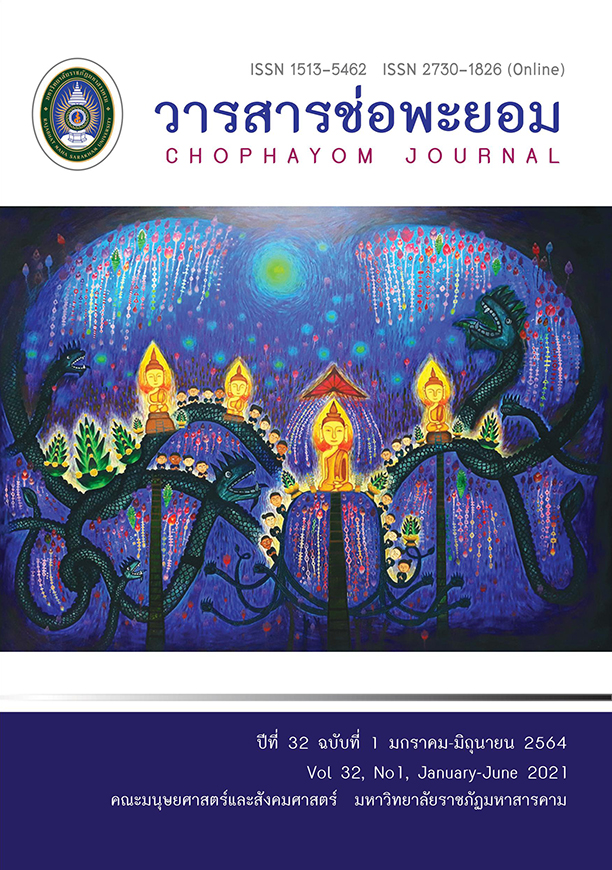Tertiary Student’s Motivation and Learning Strategies in English Language
Keywords:
แรงจูงใจ, กลวิธีการเรียนรู้ด้วยตนเอง, เรียนออนไลน์Abstract
Many institutions are currently providing online education to offer an accessible learning environment during the COVID 19 pandemic. Among all subjects, foreign languages are especially challenging to learn online. This research is set 1. to investigate the participants’ motivation and learning strategies for online English language learning and 2. to investigate the participants’ perception on motivation and learning strategies in an online English language learning class comparing to a traditional classroom. The Modified Motivation strategies for learning questionnaire (Modified MSLQ) was used as a research tool. A total of 162 students with 75 females and 87 males participated in this research. The study shows that task anxiety is the highest score on Motivation (5.89) and Critical thinking is the highest score on learning strategies (5.99). The lowest score for Motivation is on Self-efficacy (4.25). The lowest score for learning strategies covers three sub-categories: elaboration, time-management, and critical thinking (4.15). Online learning environment does not have a significant impact on the students’ motivation and learning strategies as 76.5% of the participants revealed in the open ended part of the questionnaire that there is no difference between learning English online or in the classroom regarding their motivation and learning strategies. Key words: motivation, Self-regulated Learning (SRL) Strategies, online learning
References
Artino, A. R., & McCoach, B. D. (2008). Development and initial validation of the online learning value and self-efficacy scale. Journal of Educational Computing Research, 38, 279–303.
Baturay, M. H., & Yükseltürk, E. (2015). The role of online education preferences on student’s achievement. Turkish Online Journal of Distance Education, 16(3), 3-12.
Boekaerts, M. (1997). Self-regulated learning: A new concept embraced by researchers, policy makers, educators, teachers, and students. Learning and Instruction, 7(2), 161-186.
Broadbent, J. (2017). Comparing online and blended learner’s self-regulated learning strategies and academic performance. The Internet and Higher Education, 33, 24-32.
Cull, S., Reed, D., & Kirk, K. (2010). Student motivation and engagement in online courses. In Authored as part of the 2010 workshop, Teaching Geoscience Online-A Workshop for Digital Faculty. June 28-29, 2010.
Delon, W., & McLean, E. (1992). Information systems success: The quest for the dependent variable. Information Systems Research, 3(1), 60-95.
Dornyei, Z. (1996). Moving language learning motivation to alarger platform for theory and practice. In R. L. Oxford (Ed.), Language learning motivation: Pathways to the new century (pp.89-101). Honolulu: University of Hawaii Press.
Hattie, J. (2008). Visible learning: A synthesis of over 800 meta-anal yses relating to achievement. New York, NY: Routledge.
Khatib, S. A. A. (2010). Meta-cognitive self-regulated learning and motivational beliefs as predictors of college students’ performance. International Journal for Research in Education, 27, 57-72.
King, F. B., Harner, M., & Brown, S.W. (2000). Self-regulatory behavior influences in distance learning. International Journal of In structional Media, 27(2), 147.
Kuo, Y.-C., Chu, H.-C., & Huang, C.-H. (2015). A learning style-based grouping collaborative learning approach to improve EFL students’ performance in English courses. Journal of Educational Technology & Society, 18(2), 284-298.
Kuo, Y.-C., Walker, A. E., Schroder, K. E. E., & Belland, B. R. (2014). Interaction, Internet self-efficacy, and self-regulated learning as predictors of student satisfaction in online education courses. The Internet and Higher Education, 20, 35-50.
Littlejohn, A., Hood, N., Milligan, C., & Mustain, P. (2016). Learning in MOOCs: Motivations and self-regulated learning in MOOCs. The Internet and Higher Education, 29, 40-48.
Mezei, G. (2008). Motivation and self-regulated learning: A case study of a pre-intermediate and an upper-intermediate adult student. Working Papers in Language Pedagogy, 2, 79-104.
Pintrich, P. R., Smith, D., Garcia, T., & McKeachie, W. (1991). A Manual for the Use of theMotivated Strategies for Learning Questionnaire (MSLQ). Ann Arbor, MI: The University of Michigan.
Pintrich, P. R. (2000). The role of goal orientation in self-regulated learning. In M. Boekaerts, P. Pintrich, & M. Zeidner (Eds.), Handbook of self-regulation, research, and applications (pp.451-502). Orlando, FL: Academic Press.
Selim, H. M. (2007). Critical success factors for e-learning acceptance: Confirmatory factor models. Computers & Education, 49(2), 396-413.
Zimmerman, B. J. (1986). Becoming a self-regulated learner: Which are the key subprocesses? Contemporary Educational Psychology, 11(4), 307–313.
Zimmerman, B.J. (2008). Investigating self –regulation and motivation: Historical background, methodological developments, and future prospects. American Educational Research Journal, 45, 166-183.






